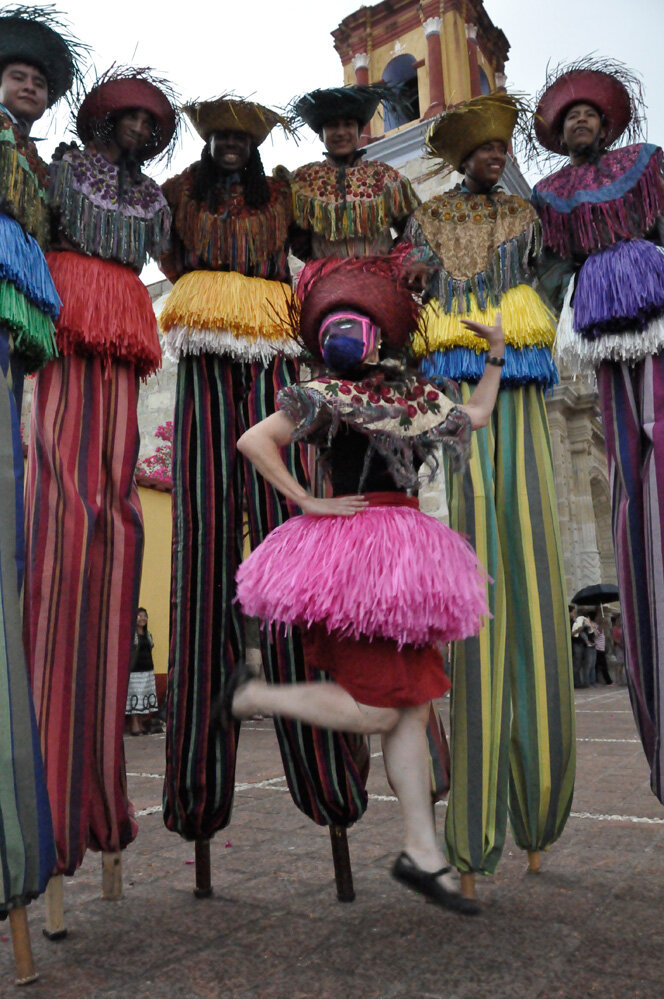Transcommunality
2007-2011
Oaxaca and New York

Festivities for San Pedro, Zaachila, Oaxaca, 2012. The Brooklyn Jumbies with Los Zancudos de Zaachila. Photo: Marco Pacheco

Performance for San Pedro festivities, Zaachila, Oaxaca, 2011. The Brooklyn Jumbies with Los Zancudos de Zaachila. Photo: Marco Pacheco

Performance for San Pedro festivities, Zaachila, Oaxaca, 2011. The Brooklyn Jumbies with Los Zancudos de Zaachila. Photo: Marco Pacheco

Processions for San Pedro, Zaachila, Oaxaca, 2011. Los Zancudos de Zaachila and The Brooklyn Jumbies. Photo: Marco Pacheco

Spontaneous Intervention, Mercado Jamaica, CDMX, 2011. The Brooklyn Jumbies. Photo: Marco Pacheco

Festival Ma (yo) Celebrando las Culturas Afrodescendientes de Oaxaca, 2011. The Brooklyn Jumbies and Los Zancudos de Zaachila. Photo: Pablo Aguinaco

Spontaneous Intervention, Mercado Jamaica, CDMX, 2011. The Brooklyn Jumbies. Photo: Marco Pacheco

Transcommunality. Performance in collaboration with the Brooklyn Jumbies and Amphibian Productions, 2008. The Modern Museum, Fort Worth. Photo: Gregory Ibañez

Jumbie Camp, 2007. Street performance, in collaboration with The Brooklyn Jumbies and Galería Ramis Barquet. Chelsea, NY. Photo: Frank Veronsky
Transcomunalidad. Oaxaca, México, 2013. Zancos realizados en colaboración con artesan@s de Oaxaca. De izquierda a derecha: Zancos Velas de Concha: Petra Mendoza, Viviana Alaves, y Guillermina Ruiz. Zancos Columnas Novohispanas: Oscar Vázquez. Zancos Máscaras: Jesús Sosa Calvo y Juana Ortega Fuentes. Zancos Jícaras: Olegario Hernández. Zancos Jicalpextles: Petronio Vazquez. Zancos Vida y Muerte: Vicente Paul y Juana Venegas.
Foto: Marco Pacheco
With the Brooklyn Jumbies. Teotitlán, Oaxaca., 2012
Photo: Marco Pacheco
“Neutral Grounds: Laura Anderson Barbata’s Path to Social Practice & Performance” By Laura Blereau
Since the early 2000s, Anderson Barbata has created wearable sculptures for use by intergenerational stilt-dancers and ground performers in street theater settings. These works are designed to be worn as garments and accessories that correspond to specific narratives and characters imagined for outdoor festivals, annual celebrations, public interventions and protests, as well as educational workshops and demonstrations of intangible cultural heritage.
Social Practice & Relationships
Anderson Barbata’s wearable sculptures are the results of prolonged community relationships and, as her oeuvre has developed over two decades, these objects have traced a living world history of stilt-dancing artistry. Performers who wear the works she designs do so based on shared goals of live participation, and together they generate an immersive transcultural dialog with the audience and other performers. Over time, three very specific communities of tradition bearers for stilt-dancing have emerged as Anderson Barbata’s repeat collaborators:
1. 2002 - 2006, Trinidad and Tobago: Moko Jumbie Keylemanjahro School of Arts and Culture; founded by Glenn “Dragon” de Souza; Cocorite neighborhood in Port of Spain
2. 2007 - ongoing, United States: Brooklyn Jumbies; founded by Najja Codrington, trained in the Chakaba stilt-dancing traditions of Senegal, and Ali Sylvester, trained by Glenn “Dragon” de Souza in Trinidad; Bedford-Stuyvesant and Flatbush neighborhoods of Brooklyn, New York, New York
3. 2009 - ongoing, Mexico: Los Zancudos de Zaachila; led by Captain Don José Medoza Ortiz[1]; San Pedro neighborhood of Zaachila, Oaxaca
How did Anderson Barbata arrive at a methodology to craft the prolonged community relationships required for such dynamic partnerships? As early as 1992, the platforms of fiber arts and education increasingly appeared in her collaborations – such as G.R.A.S. in Trinidad and The Yanomami Paper Project in the Venezuelan Amazon, two social enterprises focused on ecologically sustainable hand papermaking.[2] Over many years, these activities yielded tools for sharing skills and traditions (including books, paper, drawings and instructional videos) while simultaneously increasing the cultural visibility of community participants. During this period Anderson Barbata came to understand art as a system of shared practical actions that have the capacity to increase communication around topics of cultural diversity and to create sites of human connection or belonging.
[1] At age 81, “Tio José” passed away on March 22, 2021, after leading his stilt-dancing community for over 60 years.
[2] Melissa Potter, Among Tender Roots (Chicago: Center for Book & Paper Arts, Columbia College, 2010).
Except from the introductory text for the exhibition Transcommunality at the Newcomb Art Museum of Tulane University, New Orleans.
“Neutral Grounds: Laura Anderson Barbata’s Path to Social Practice & Performance”
By Laura Blereau, April 2021
This video provides a glimpse into the collaboration between Laura Anderson Barbata and the Brooklyn Jumbies, a group of stilt dancers whose traditions stem from West Africa and the West Indies. Barbata and the Brooklyn Jumbies met in 2006, and shortly thereafter began collaborating. They continue to work together and have presented their work in Mexico, New York, Fort Worth, Madison, Singapore and Jamaica.
Video by Alix Milne
Still Photography by Frank Veronsky

